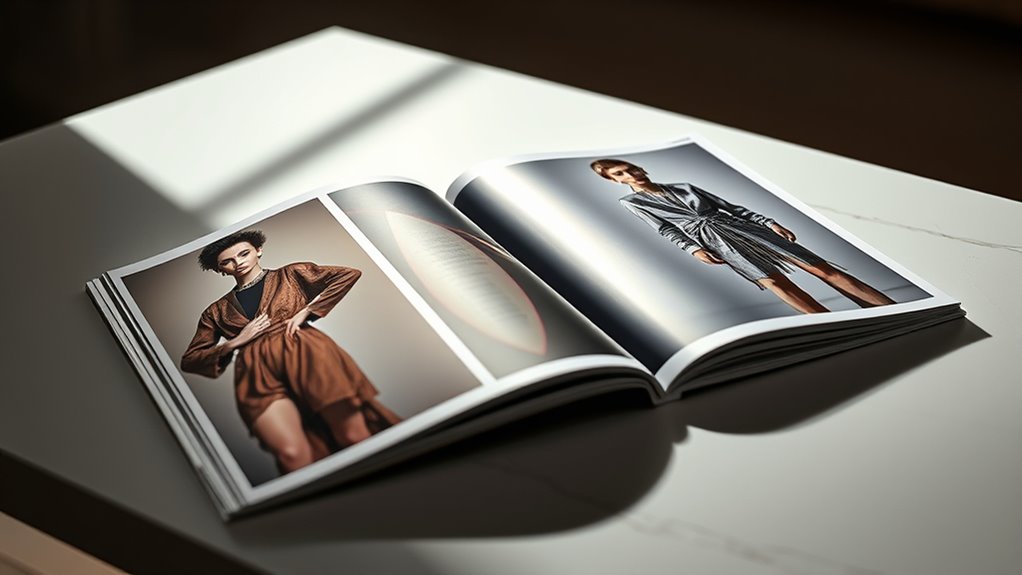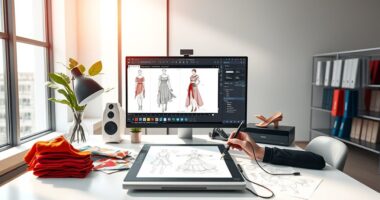To catch a fashion recruiter’s eye, focus on showcasing your understanding of sustainable materials and runway-inspired styling. Highlight eco-friendly fabrics, bold silhouettes, and innovative techniques that reflect current industry trends. Organize your portfolio with high-quality images and clear descriptions that explain your design choices and craftsmanship. Demonstrate authenticity and an awareness of the fashion landscape to stand out. Keep exploring these tips to build a portfolio that truly embodies your talent, values, and future potential.
Key Takeaways
- Showcase sustainable materials with clear descriptions to demonstrate eco-conscious choices and industry awareness.
- Highlight runway-inspired styling through bold silhouettes and statement details for a high-fashion impact.
- Organize your portfolio with high-quality images and consistent formatting for effortless review.
- Explain your design process and material selections to convey authenticity and thoughtful craftsmanship.
- Incorporate innovative trends and industry insights to reflect awareness of current fashion shifts and future potential.

Your portfolio is often the first impression fashion recruiters see, so making it stand out is essential. When they flip through your work, they want to see more than just pretty designs; they want to understand your vision, skill, and awareness of current industry trends. One way to catch their attention immediately is by showcasing your knowledge of sustainable materials. Including pieces that highlight eco-friendly fabrics or innovative green techniques signals that you’re conscious of the industry’s shift toward sustainability. It demonstrates that you’re not only talented but also responsible and forward-thinking—qualities highly valued in today’s fashion world. Make sure your portfolio clearly details your use of sustainable materials, perhaps with brief descriptions of why you chose specific fabrics or how they contribute to eco-conscious fashion. This shows recruiters that you’re up-to-date with industry trends and committed to making a positive impact. Additionally, emphasizing authenticity in design choices can help convey your genuine understanding of sustainable practices and craftsmanship.
Next, pay close attention to runway styling within your portfolio. Recruiters love to see how you interpret high fashion and translate runway trends into wearable, innovative designs. Your work should reflect a keen eye for runway styling—bold silhouettes, statement accessories, and daring color palettes—showcasing your ability to draw inspiration from the runway while also making it practical. Include mood boards, sketches, or photographs of your actual designs styled in a manner reminiscent of runway shows. This not only reveals your technical skill but also your capacity to think creatively at a high level. Remember, the goal is to present a cohesive story through your portfolio: one that exhibits your understanding of current trends and your ability to adapt them into original, compelling work.
Moreover, be strategic about the presentation. Keep your portfolio organized and professional, with high-quality images that accurately depict your designs. Use clean layouts and consistent formatting to make browsing effortless. When describing your pieces, focus on clarity—highlight your design process, the inspiration behind each look, and your choice of sustainable materials or runway styling elements. This helps recruiters see the thought process behind your work, making it more memorable. Your portfolio isn’t just a collection of pretty images; it’s a narrative of your skills, your values, and your potential to contribute to the industry. By emphasizing sustainable materials and runway styling, you demonstrate your awareness of what’s current and your readiness to innovate within the fashion landscape, making it impossible for recruiters to overlook your talent.
Frequently Asked Questions
How Should I Tailor My Portfolio for Specific Fashion Brands?
To tailor your portfolio for specific fashion brands, start with brand research techniques like analyzing their aesthetic, values, and target audience. Use brand-specific customization by highlighting projects that align with their style and ethos. Showcase your versatility while emphasizing how your skills meet their needs. This personalized approach demonstrates your genuine interest and understanding, making your portfolio stand out to recruiters and increasing your chances of landing the job.
What Common Mistakes Do Applicants Make in Their Portfolios?
You might think your portfolio’s perfect, but many overlook major mistakes! The biggest one is neglecting branding consistency—your work should tell a cohesive story. Also, poor technical presentation can sink your chances; blurry images or sloppy layouts scream unprofessional. Avoid these pitfalls, and you’ll stand out like a shining star. Remember, attention to detail and a unified style are what truly catch recruiters’ eyes!
How Important Are Social Media Links in a Fashion Portfolio?
Social media links can boost your fashion portfolio by showcasing your social media presence and online portfolio. Recruiters often look for candidates with active, engaging platforms that demonstrate your style and personality. Including links to your Instagram or Behance gives them quick access to your work and personality, making your portfolio more dynamic. Just guarantee your social media is professional and aligns with your brand, enhancing your overall presentation.
Should I Include Personal Projects or Only Professional Work?
You should include both personal projects and professional work to showcase your personal branding and creative storytelling skills. Personal projects reveal your unique vision and passion, helping recruiters see your full potential. Professional work demonstrates your technical abilities and experience. Combining both creates a well-rounded portfolio that highlights your versatility and authentic voice, making it easier for recruiters to connect with your creative narrative and see your genuine talent.
How Often Should I Update My Fashion Portfolio?
You should update your fashion portfolio seasonally to showcase your latest work and maintain portfolio diversity. Regular updates keep your portfolio fresh and relevant, demonstrating your growth and adaptability. Aim to refresh it at least four times a year, aligning with fashion seasons. This approach guarantees recruiters see your evolving skills and creative range, making your portfolio more compelling and increasing your chances of standing out.
Conclusion
Think of your portfolio as a vibrant garden. Each piece is a colorful flower that catches the eye, but only if it’s well-arranged and cared for. When you showcase your best work clearly and thoughtfully, recruiters walk through your garden with ease, pausing to admire your unique blooms. Keep your display fresh, balanced, and intentional, and you’ll invite them to linger, see your talent’s full beauty, and pick your design as the standout in their garden of options.










